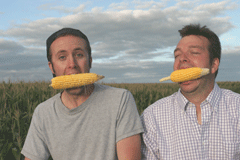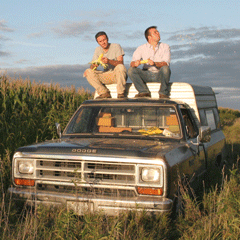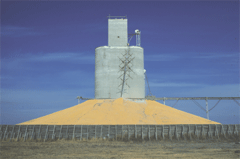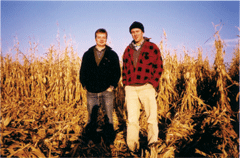An Earful on Corn
Air Date: Week of October 12, 2007

Ian Cheney (left) and Curt Ellis taste their harvest in Greene, Iowa. (Photo: Sam Cullman)
The fate of yellow dent corn is traced from soil to supermarket in the new documentary "King Corn." Abundant, cheap, and rich in calories, the crop is found in almost everything we eat. And, as the U.S. government continues to subsidize commercial farms to drive prices down and yield up, Americans struggle with the consequences of a high-calorie, low-nutrition diet. Living on Earth’s Bruce Gellerman gets an earful from co-producer Ian Cheney about the making of the movie.
Transcript
CURWOOD: Since the mid 1970s the United States has been undergoing a huge experiment. That’s when Earl Butz, then Secretary of Agriculture during the Nixon administration, announced a radical change in the nation’s farm policy.
BUTZ: What we want out of agriculture is plenty of food and that's our drive now. We have experienced a 180-degree turn in the philosophy of our farm programs. We've abandoned the long-time philosophy of curtailment and cutback to the new philosophy of expansion. And it makes sense.
CURWOOD: And lots of dollars. The policy of encouraging farmers to plant from fence line to fence line has produced bumper crops and changed the way Americans eat. In their movie “King Corn,” filmmakers Curt Ellis, Aaron Woolf and Ian Cheney chronicle the controversial change in America’s farm policy and its link to our diet. The documentary is a penetrating, at times humorous, indictment of the colossus of all crops: corn. Living on Earth’s Bruce Gellerman recently spoke with filmmaker Ian Cheney.
GELLERMAN: So how do two city guys from Boston, not far from here, come up with the idea of making a movie about corn?
CHENEY: When we graduated from college, we were confronted, one way or another, with a pretty startling realization.
GELLERMAN: You had to make a living.
CHENEY: We had to make a living. Yeah. We had to do something with ourselves. We couldn’t just keep reporting to the dorms. And the other realization was that, because of the direction of the American diet, there were a lot of studies coming out saying that our generation might actually have a shorter life span than our parents’ because of diet-related diseases, obesity, diabetes, heart disease. And—at 22—it seemed like a worthy mission to figure out, if what we’re eating is making us sick—what are we eating?

King Corn co-producers Curt Ellis and Ian Cheney perform a taste test in their acre of corn in Greene, Iowa (Photo: Sam Cullman)
CHENEY: Yeah, Steve Macko is a professor at the University of Virginia and he had been testing his students and coming up with some pretty startling results. And we sent him some of our baby hair and some of our adult hair and he noticed a difference, actually, between those two samples. He noticed that our adult hair was made out of carbon that seemed to be coming from corn. Corn—the way it photosynthesizes carbon—leaves a kind of a signature that he could trace with his maspectrometer. You are what you eat, I mean, most of my calories, growing up here in Boston, were coming from a cornfield in Iowa.
GELLERMAN: So you rent an acre of land in Iowa.
CHENEY: Mmm Hmm. We rented an acre. We didn’t even know how big an acre was. And we found a willing farmer in the town where my great grandfather grew up and my friend Curt’s great grandfather grew up. And I think he was amused that a couple of city kids were coming out to try and learn how to do agriculture.

A corn pile outside one of Iowa’s ubiquitous grain elevators. (Photo: Bryan Cheney)
CHENEY: Right. Almost all the corn you see when you drive across the country is, you know, so-called ‘field corn’ or it’s also called ‘yellow dent corn.’ And it’s really inedible. You can’t eat what you grow as a farmer in Iowa for the most part—if you’re growing corn and soy beans.
GELLERMAN: But everything you eat winds up having field corn in it.
CHENEY: Yeah. You can stroll down pretty much any aisle in the supermarket and pick up a box or a can or a tube and find an ingredient in there that, if it doesn’t say corn, it probably is made from corn—everything from multidextrin to cornstarch to high-fructose corn syrup.
GELLERMAN: In the movie, you meet a guy whose license plate is ‘CORN FED.’ And he’s on line; he’s waiting in his car to chow down at one of these fast-food restaurants. And boy, that’s quite a scene.
[SCENE FROM “CORN KING” FADES IN]
MAN: What are you eating for lunch today?
MAN 2: Corn fed beef.
MAN: Do you actually know anything about corn fed beef? Do you know what it does to ‘em? To the cattle. It’s a good thing they slaughter them when they do because it actually kills them to feed them to make the meat like that. So they’d be dead in six months anyway eating that stuff so it’s just as well that they slaughter them.
MAN 2: Really?
MAN: Yeah, it’s terrible.
MAN 2: Where is this?
MAN: Every major confinement feed lot everywhere.
[SCENE FROM “CORN KING” FADES OUT]
CHENEY: Cattle didn’t evolve to eat grains. They evolved to eat grass.
GELLERMAN: Actually, in the film you make the point that if the cattle continue to eat corn, they’ll eventually die.
CHENEY: Yeah, it makes them sick.
GELLERMAN: It’s a poison for them.
CHENEY: Yeah, we hadn’t seen anything like this in Iowa so it sparked our trip out to Colorado, east of the Rockies, to see where beef comes from.
GELLERMAN: And it comes—not from contented cows.
CHENEY: No, uh, they didn’t look that happy.
GELLERMAN: They jam these cows into these feedlots, they limit the amount of walking around they can do because that would burn calories, they stuff ‘em with corn, and then, a couple of months later, they turn ‘em into burgers.

Curt Ellis (left) and Ian Cheney at their acre on harvest day. (Photo: Sam Cullman)
CHENEY: It turns your stomach to get that close to where your food comes from. And it was, I think, one of the reasons that we started out making the film is because we felt that growing up eating in the cities you’re pretty far away from where your food comes from and from the realities of it. So it’s easy to chomp a hamburger in Boston if your mind has never received an image of a big feedlot in Colorado.
GELLERMAN: You meet a guy in Brooklyn who’s a cab driver and he describes how his father has diabetes, and his mother’s got diabetes, and his sister’s got diabetes. And they’re all dying.
[SCENE FROM “CORN KING” FADES IN]
CAB DRIVER: My mom died of a direct result of diabetes. My grandmother died a direct result of diabetes. My sister Madeleine, she’s been a diabetic for years. I was recently diagnosed with diabetes. We don’t think of what we’re putting into our system. We don’t really think about it.
[SCENE FROM “CORN KING” FADES OUT]
CHENEY: There’s a lot of families like that in New York and around the country. In New York one in eight people have diabetes. It, statistically, wasn’t that improbable to hop into a cab and have your cab driver point out that his life is being ruined by diabetes. And he felt that the culprit was high-fructose corn syrup. I don’t think we will ever say, ‘type 2 diabetes is caused by corn syrup,’ but I think we can say that our diet-related diseases are related to our diet and what our diet consists of is a heck of a lot of fatty foods and a heck of a lot of sweet foods.
GELLERMAN: Ian, at the end of your movie—you had to rent the land, buy the seed, the fertilizer, machinery and all the rest of it—did you make any money off of your acre of land?

Ian Cheney (left) and Curt Ellis taste their harvest in Greene, Iowa. (Photo: Sam Cullman)
CHENEY: We didn’t make a penny off of our acre of corn. We lost money. There was so much corn grown that year that the price of corn was incredibly low. And so, even though we did a great job growing our corn—we had a real bumper crop of 177 bushels—we lost money. So we learned that that was offset, as was the case on every other Iowa farm, by government subsidies—three different government subsidies.
GELLERMAN: So if it wasn’t for these government subsidies these farmers would be losing money on every bushel they raise.
CHENEY: The farm bill for a long time has been the economy in a lot of small Iowa towns.
GELLERMAN: So if you work backwards, and you say, ‘we’re putting the farmers out of business, we’re costing the government many billions of dollars, we’re killing ourselves by eating this type of food’—maybe I’m missing something.
CHENEY: You’re not missing a thing! You’re just describing a system that is the unfortunate consequence of good intentions; trying to make food cheaper and more readily available, trying to make farmland more productive, trying to make farm work easier, and trying to help farmers make a living. Those were all the reasons we put this system in place. We’ve just taken it, maybe, too far. Perversely too far.
CURWOOD: Filmmaker Ian Cheney speaking with Living on Earth’s Bruce Gellerman. Mr. Cheney, along with Curtis Ellis and Aaron Woolf, produced the documentary film “King Corn.” It just opened in New York City and will be in theaters nationwide in November.
Links
Living on Earth wants to hear from you!
Living on Earth
62 Calef Highway, Suite 212
Lee, NH 03861
Telephone: 617-287-4121
E-mail: comments@loe.org
Newsletter [Click here]
Donate to Living on Earth!
Living on Earth is an independent media program and relies entirely on contributions from listeners and institutions supporting public service. Please donate now to preserve an independent environmental voice.
NewsletterLiving on Earth offers a weekly delivery of the show's rundown to your mailbox. Sign up for our newsletter today!
 Sailors For The Sea: Be the change you want to sea.
Sailors For The Sea: Be the change you want to sea.
 The Grantham Foundation for the Protection of the Environment: Committed to protecting and improving the health of the global environment.
The Grantham Foundation for the Protection of the Environment: Committed to protecting and improving the health of the global environment.
 Contribute to Living on Earth and receive, as our gift to you, an archival print of one of Mark Seth Lender's extraordinary wildlife photographs. Follow the link to see Mark's current collection of photographs.
Contribute to Living on Earth and receive, as our gift to you, an archival print of one of Mark Seth Lender's extraordinary wildlife photographs. Follow the link to see Mark's current collection of photographs.
 Buy a signed copy of Mark Seth Lender's book Smeagull the Seagull & support Living on Earth
Buy a signed copy of Mark Seth Lender's book Smeagull the Seagull & support Living on Earth

